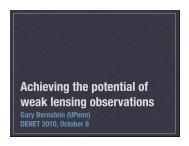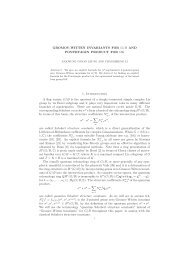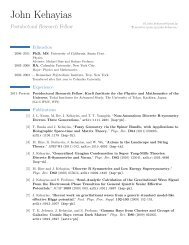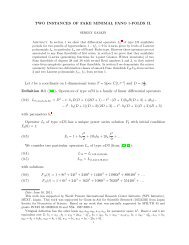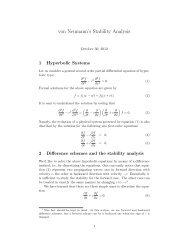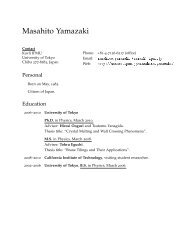STUDY SUMMARY - IPMU
STUDY SUMMARY - IPMU
STUDY SUMMARY - IPMU
Create successful ePaper yourself
Turn your PDF publications into a flip-book with our unique Google optimized e-Paper software.
<strong>SUMMARY</strong> REPORT<br />
WIDE FIELD FIBER-FED OPTICAL<br />
MULTI-OBJECT SPECTROMETER (WFMOS)<br />
7.4 Risk Management<br />
Risk Management is used to balance the project risk position across all project resource areas<br />
(instrument success, technical reserves, schedule and cost reserves), controlling the distribution<br />
and magnitude of the identified risks against the cost constraints while obtaining the best possible<br />
confidence in achieving high science return. Accurate assessment of the risks and taking action<br />
in a timely manner is critical to managing the technical delivery and cost of this instrument.<br />
The risk management strategy consists of risk identification, risk assessment, and risk mitigation.<br />
Risk identification defines the risk, likelihood of occurrence, and impact of the occurrence<br />
and is captured in a standard format as shown in Figure 7.4-1. All elements of the project, including<br />
reviewers, are involved in risk identification, and the risk list is managed by the system engineer.<br />
The risks and their ranking shown here represent the knowledge at this stage of the design.<br />
Risk items are reviewed monthly to track change in status as the instrument development proceeds<br />
and to identify whether any mitigation strategies need to be exercised. The top high-level<br />
risks for the WFMOS instrument are shown on this chart.<br />
LIKELIHOOD<br />
5<br />
4<br />
3<br />
2<br />
1<br />
Criticality<br />
2<br />
4, 5<br />
6, 7<br />
3<br />
1 2 3 4 5<br />
1<br />
CONSEQUENCE<br />
Implement new<br />
process(es) or change<br />
baseline plan(s)<br />
Aggressively manage;<br />
consider alternative<br />
process<br />
Risk Assessment Criteria for Consequence and Likelihood<br />
Risk Type (either or both may apply to each risk)<br />
Operational Risk<br />
Implementation Risk<br />
Consequence of Occurrence<br />
Level Implementation Risk Level Definition<br />
5 Cannot complete with current budget and resources<br />
4 Consume all contingency, budget or schedule, >90%<br />
3 Significant reduction in contingency or schedule slack, >50%<br />
2 Small reduction in contingency or schedule slack, >10%<br />
1 Minimal reduction in contingency or schedule slack, >1%<br />
Likelihood of Occurrence<br />
Level Likelihood Level Definition (*)<br />
5 Very High almost certain > 70%<br />
4 High More likely than not > 50%<br />
3 Moderate Significant likelihood >30%<br />
2 Low Unlikely > 1%<br />
1 Very Low Very unlikely



